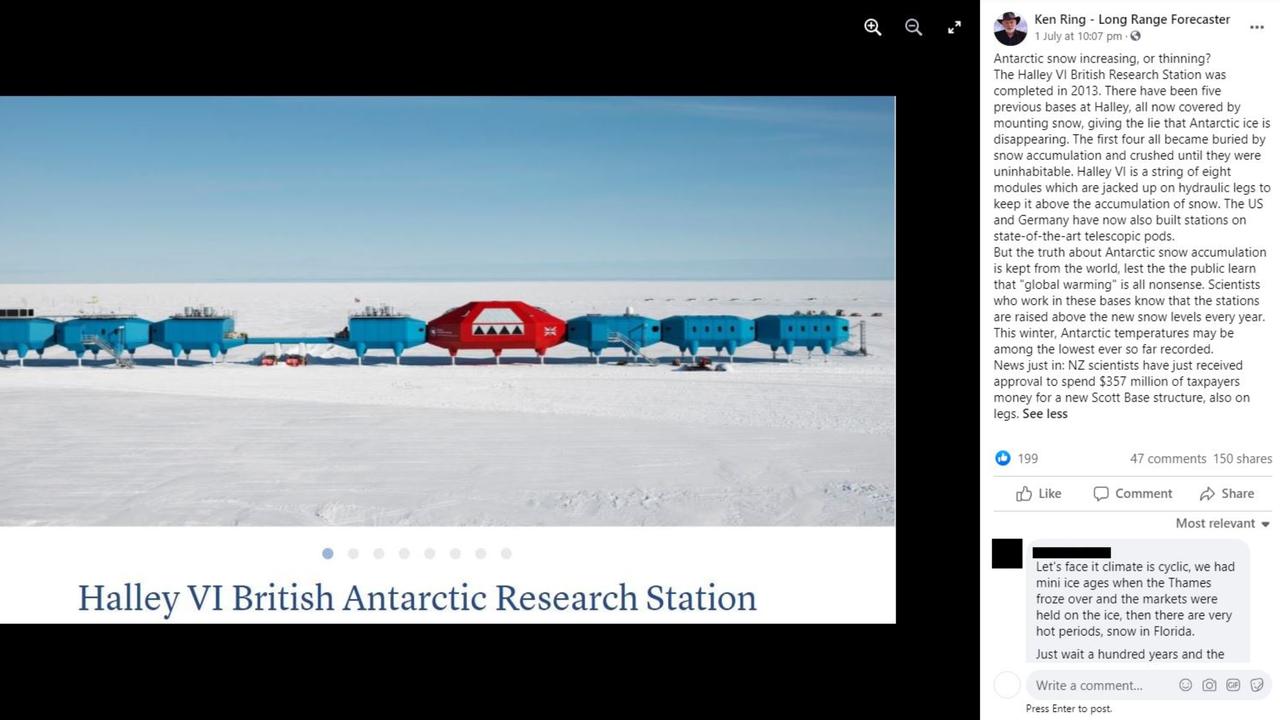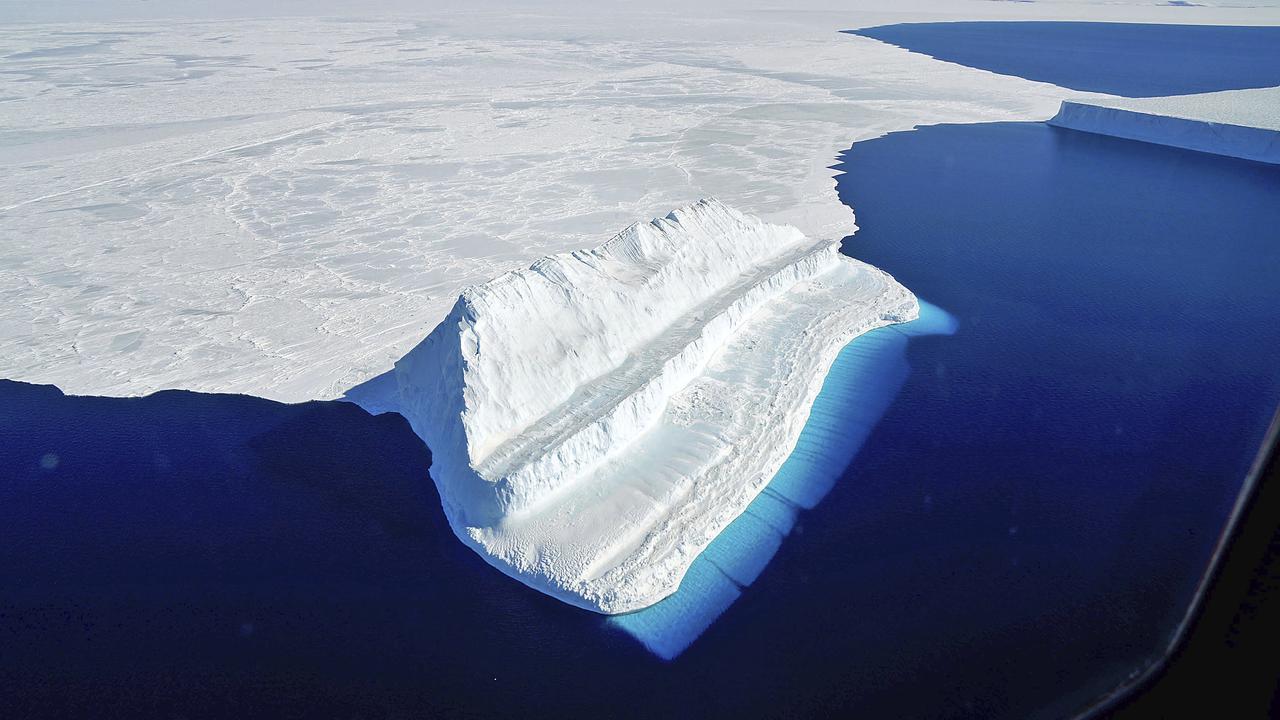The Statement
A Facebook post claims Antarctica is not losing ice because a number of British Research Station bases have previously been destroyed by mounting snow.
The July 1 post by Ken Ring, an astrological weather forecaster from New Zealand, features a photo of the UK's Antarctic Halley VI Research Station. Its caption claims: "There have been five previous bases at Halley, all now covered by mounting snow, giving (sic) the lie that Antarctic ice is disappearing."
It goes on to state: "The truth about Antarctic snow accumulation is kept from the world, lest the the (sic) public learn that 'global warming' is all nonsense."
The post also predicts Antarctica may experience some of its lowest temperatures ever recorded this winter.

The Analysis
While several British Halley bases were destroyed by mounting snow, this fact is unrelated to disappearing Antarctic land ice or climate change.
Several experts told AAP FactCheck the bases were built on top of ice sheets away from where ice melting or breakaways occur, which results in them being covered in ice and snow during regular accumulation. However, Antarctica is losing land ice overall.
The British Antarctic Survey's (BAS) Halley base was established in 1956 and is used for atmospheric science, geology and glaciology research. Since then, there have been five bases - including the current base Halley VI - all constructed on the Brunt Ice Shelf. Four of them were eventually rendered uninhabitable.
The shelf records approximately 1.2 metres of snow annually, making it necessary to periodically rebuild the bases as they become covered in snow and get crushed, according to the BAS.
Andrew Shepherd, a professor of earth observation at the University of Leeds with expertise in polar and climate science, told AAP FactCheck that Antarctic bases like Halley only experienced snowfall as they were placed on top of the ice sheet, where little melting or ice breakaway occurred.
"Anything placed on top of the ice sheet will get buried over time and eventually either end up at the base or the edge (through ice movement transporting older ice towards the edge) where it will then either melt out or break free," Prof Shepherd said in an email.
Ian Simmonds, a professor at the University of Melbourne's School of Earth Sciences, agreed, telling AAP FactCheck in an email: "Precipitation falls over the continent and this means that at most places over Antarctica objects located on the surface will ultimately be buried. While this is true it is, on its own, irrelevant to the argument that the continent is gaining mass."
For the claim that Antarctica's disappearing ice is a "lie", the experts said there is a consensus backed by scientific evidence to show that Antarctica is losing ice.
Prof Shepherd described the post as misleading as it appeared to be based solely on Antarctic snowfall, which he said was only half of the story.
"Antarctica does receive around 2098 billion tons of snow each year (1979-2008 average), but it also loses around 2306 billion tons per year (2009-2017 average) due to icebergs calving from the edge and ice melting from the base," he said.
"So it is losing 208 billion tons of ice per year overall which means it is shrinking, not growing."
Professor Rob DeConto, a polar climate change expert at the University of Massachusetts, said Antarctica is losing ice "at a quacking pace".
"The rate of ice loss is accelerating (demonstrated by multiple lines of evidence and with high confidence). The pace of ice loss has tripled in the decade from 2007 to 2017, relative to the previous decade, mainly in response to change in the flow of the ice sheet triggered by warm ocean waters in contact with the edge of the ice sheet," he told AAP FactCheck in an email.
The US-based National Snow and Ice Data Center says the Antarctic peninsula is experiencing ice loss as it has warmed by 2.5 degrees Celsius since 1950, while a large area of the west Antarctic ice sheet is also losing mass.
NASA satellite data indicates Antarctica's land ice sheet is losing 151 billion metric tons of ice per year, the organisation says. The ice sheet is the largest store of frozen freshwater in the world.
Prof Simmonds identified that the term "Antarctic ice" can be defined by three main categories: the ice sheet covering Antarctica's land and bedrock; sea ice, which floats on the ocean; and the ice shelf, permanent floating ice sheets connected to the Antarctic landmass.
Of these, only sea ice levels have remained relatively steady, according to data from the UK's Royal Society, the National Oceanic and Atmospheric Administration (NOAA) and NASA. Prof Simmonds said Antarctic sea ice levels had increased until around 2015 but had since started showing declines.
The experts also disputed the claim that Antarctica may record some of its lowest temperatures this winter.
Prof Simmonds said while parts of Antarctica experienced unseasonably cold weather recently due to a polar vortex, this is part of the natural climate system.
"It is ingenuous to pick on an isolated (in time and/or space) event to make a broad statement about the whole climate system," he said.
Similarly, Professor Chris Rapley, an expert in climate and polar science at University College London and former director of the British Antarctic Survey, told AAP FactCheck that "one swallow doesn't make a summer".
"If there has been or is predicted to be a low extreme, it does not invalidate a trend," he said in an email.
A scientific paper co-authored by Prof Simmonds details an overall warming trend over the entire Antarctic continent from 1950 to 2020 (Figure 1a), while the World Meteorological Organization this month recognised a new record high Antarctic temperature of 18.3C.
AAP FactCheck sought comment from Mr Ring on the Facebook post but received no response.

The Verdict
The destruction of the British Antarctic Survey's Halley research stations by snowfall is unrelated to global warming or the disappearance of ice from Antarctica. Rather, anything placed on the Antarctic ice sheet will get buried by regular snowfall over time. Overall, Antarctica is losing ice, experts and various monitoring organisations say.
False – Content that has no basis in fact.
AAP FactCheck is an accredited member of the International Fact-Checking Network. To keep up with our latest fact checks, follow us on Facebook and Twitter.












